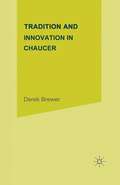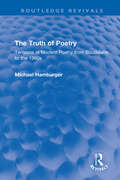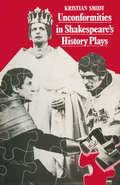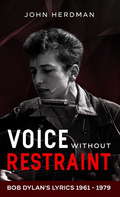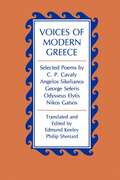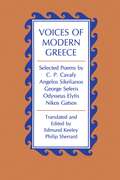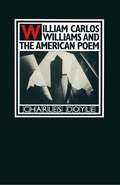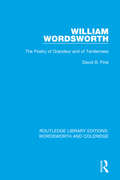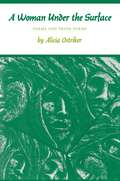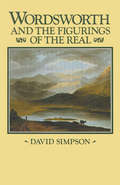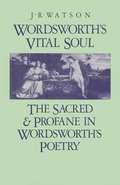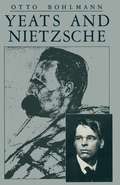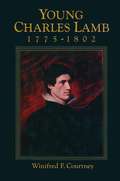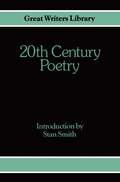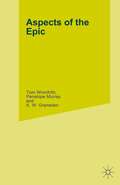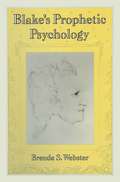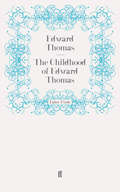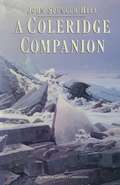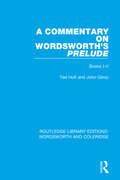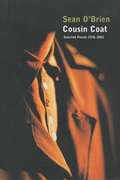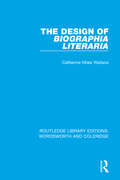- Table View
- List View
The Truth of Poetry: Tensions in Modern Poetry from Baudelaire to the 1960s (Routledge Revivals)
by Michael HamburgerFirst published in 1982, The Truth of Poetry attempts to answer a seemingly simple question: What kind of truth does poetry offer in modern times? Michael Hamburger’s answer to this question ranges over the last century of European and American poetry, and the result is a phenomenology of modern poetry rather than a history of appreciations of individual poets. Stressing the tensions and conflicts in and behind the work of every major poet of the period, he considers the many different possibilities open to poets since Baudelaire. This expansive work of analysis will be of interest to students of English literature, poetry enthusiasts and literary historians.
The Truth of Poetry: Tensions in Modern Poetry from Baudelaire to the 1960s (Routledge Revivals)
by Michael HamburgerFirst published in 1982, The Truth of Poetry attempts to answer a seemingly simple question: What kind of truth does poetry offer in modern times? Michael Hamburger’s answer to this question ranges over the last century of European and American poetry, and the result is a phenomenology of modern poetry rather than a history of appreciations of individual poets. Stressing the tensions and conflicts in and behind the work of every major poet of the period, he considers the many different possibilities open to poets since Baudelaire. This expansive work of analysis will be of interest to students of English literature, poetry enthusiasts and literary historians.
Voice Without Restraint: Bob Dylan's Lyrics 1961 - 1979
by John HerdmanBob Dylan was awarded the Nobel Prize in Literature in June 2016, and seldom in recent years has it been more richly deserved.That a song writer’s lyrics should be regarded as literature was an idea at which many were surprised.Others have felt that to isolate the lyrics of a song from its musical context is unreal. Ultimately that is true: a song is an indefeasible whole, an inseparable marriage of words and music which achieves its overall emotional effect by that symbiosis and not otherwise.Yet it can also be said that the two components can be separately considered as two elements in the artist’s creative utterance, and discussed as such.The evidence of Dylan’s manuscripts supports the view that in writing his lyrics his way of going about things is not always widely different from that of a poet.Bob Dylan commented on the Nobel Prize in Literature which was awarded to him "for having created new poetic expressions within the great American song tradition": "When I first received this Nobel Prize for Literature, I got to wondering exactly how my songs related to literature. I wanted to reflect on it and see where the connection was."Voice Without Restraint, refers to and is from the song “I dreamed I saw St Augustine” on John Wesley Harding, and is a phrase chosen to evoke the full-blooded commitment to his artistic utterance which is the hallmark of Bob Dylan’s voice – in all senses.
Voices of Modern Greece: Selected Poems by C.P. Cavafy, Angelos Sikelianos, George Seferis, Odysseus Elytis, Nikos Gatsos
by Edmund Keeley Philip SherrardThis anthology is composed of recently revised translations selected from the five volumes of work by major poets of modern Greece offered by Edmund Keeley and Philip Sherrard during the past two decades. The poems chosen are those that translate most successfully into English and that are also representative of the best work of the original poets. C. P. Cavafy and Angelos Sikelianos are major poets of the first half of the twentieth century. George Seferis and Odysseus Elytis, who followed them, both won the Nobel Prize in literature. Nikos Gatsos is a very popular translator, lyricist, and critic.
Voices of Modern Greece: Selected Poems by C.P. Cavafy, Angelos Sikelianos, George Seferis, Odysseus Elytis, Nikos Gatsos
by Edmund Keeley Philip SherrardThis anthology is composed of recently revised translations selected from the five volumes of work by major poets of modern Greece offered by Edmund Keeley and Philip Sherrard during the past two decades. The poems chosen are those that translate most successfully into English and that are also representative of the best work of the original poets. C. P. Cavafy and Angelos Sikelianos are major poets of the first half of the twentieth century. George Seferis and Odysseus Elytis, who followed them, both won the Nobel Prize in literature. Nikos Gatsos is a very popular translator, lyricist, and critic.
William Wordsworth: The Poetry of Grandeur and of Tenderness (RLE: Wordsworth and Coleridge)
by David B. PirieFirst published in 1982. In this study of Wordsworth’s major poetry, the author explores the conflict between the poet’s celebration of an impersonal earth and his concern for the most intensely personal relationships. The opening chapter concentrates on Wordsworth’s struggle to describe the natural world and the extraordinary claims he makes for the natural landscape — which are shown to derive not from vague mysticism but precisely articulated common sense. The close readings of Michael, The Idiot Boy, Tintern Abbey and The Ruined Cottage, and poems as passages on solitaries are supported by generous quotations and discussion of other critical views.
William Wordsworth: The Poetry of Grandeur and of Tenderness (RLE: Wordsworth and Coleridge)
by David B. PirieFirst published in 1982. In this study of Wordsworth’s major poetry, the author explores the conflict between the poet’s celebration of an impersonal earth and his concern for the most intensely personal relationships. The opening chapter concentrates on Wordsworth’s struggle to describe the natural world and the extraordinary claims he makes for the natural landscape — which are shown to derive not from vague mysticism but precisely articulated common sense. The close readings of Michael, The Idiot Boy, Tintern Abbey and The Ruined Cottage, and poems as passages on solitaries are supported by generous quotations and discussion of other critical views.
A Woman Under the Surface: Poems and Prose Poems (Princeton Series of Contemporary Poets #162)
by Alicia OstrikerFrom A Woman Under the Surface:MOON AND EARTH Alicia Ostriker ? Of one substance, of oneMatter, they have cruellyBroken apart. They never will touch Each other again. The shiningLovelier and youngerTurns away, a pitiful girl. She is completely nakedAnd it hurts. The largerMotherly one, breathlessly luminous Emerald, and blue, and whiteTraveling mists, suffersBirth and death, birth and death, and the shockOf internal heat killed by external cold.They are dancing through that blackness. They press as ifTo come closer.
A Woman Under the Surface: Poems and Prose Poems (Princeton Series of Contemporary Poets #162)
by Alicia OstrikerFrom A Woman Under the Surface:MOON AND EARTH Alicia Ostriker ? Of one substance, of oneMatter, they have cruellyBroken apart. They never will touch Each other again. The shiningLovelier and youngerTurns away, a pitiful girl. She is completely nakedAnd it hurts. The largerMotherly one, breathlessly luminous Emerald, and blue, and whiteTraveling mists, suffersBirth and death, birth and death, and the shockOf internal heat killed by external cold.They are dancing through that blackness. They press as ifTo come closer.
Wordsworth and the Figurings of the Real
by David SimpsonPerhaps the most powerful feature of the Romantic imagination is its ability to dissolve existing form and order and create it anew. The Romantic investigation of the functions of the imagination also leads to important insights concerning its problems and dangers. Because it separates the person experiencing it from others around him, the imagination introduces ways of seeing which cannot be assumed to be simply communicable or easily shared, and which have as their objects different forms or 'things'. These forms, or figures, risk becoming for their originators both vehicles of power, in so far as they do convince others of their reality, and limiting constructs of prefigured order, inhibiting their users from the perception of new relations and alternative meanings. When the figured becomes the real, there thus arise difficulties in both individual and social perceptions. Arguing from the stance that all perception takes place by a creative (and hence potentially divisive) assembly of images or qualities into things, David Simpson shows that the analysis of figurative representation in Wordsworth's writing is of central importance to his idea of the human mind, and the way in which it is affected or allowed to function by its environment, both human and physical. In this way Wordsworth's ideas about the function of literature in society are seen to be more fully worked out than readers have often assumed them to be. Simpson pays particular attention to the ethical consequences of different ways of figuring the real, offering an explanation of Wordsworth's distinction between life in the town and life among the mountains and lakes of north-west England. In relating Wordsworth's poetry to important contemporary debates in political economy such as those concerning the division of labour and the evaluation of the advantages and disadvantages of commerce and luxury, he suggests that Wordsworth is a notable precursor of that nineteenth-century tradition which sees the mind as open to critical determination by social and environmental factors.
Yeats and Nietzsche: An Exploration of Major Nietzschean Echoes in the Writings of William Butler Yeats
by Otto BohlmannThe Childhood of Edward Thomas
by Edward ThomasKilled at Arras in 1917, Edward Thomas left behind him a short, vivid history of his own early life, covering the period from his birth to his entry into St Paul's. Though a fragment, in many senses it is far more: in the words of its author 'no less than an autobiography . . . an attempt to put down on paper what [this author] sees when he thinks of himself from 1878 to about 1895'. The Childhood of Edward Thomas was not published until 1938, over two decades after Thomas originally showed the manuscript to a publisher. Those eventual publishers, Faber & Faber, were building on their release two years earlier of Thomas's Collected Poems, for which he was becoming best known.This edition includes Edward Thomas's 'War Diary,' a record of the last three months of his life when, as an elderly - at thirty-eight - subaltern he fought among the misery of the trenches. To witness Thomas's childhood memoir and wartime diaries in such close proximity is to have a moving incarnation of his distinctive voice, its clarity and - even in war - its unfailing attention to his fellow-creatures.
A Coleridge Companion: An Introduction to the Major Poems and the Biographia Literaria (pdf) (Literary Companions)
by John Spencer HillA Commentary on Wordsworth's Prelude: Books I-V (RLE: Wordsworth and Coleridge)
by Ted Holt John GilroyFirst published in 1983, this books aims to guide Wordsworth students through his difficult masterpiece by reading it in continuous sequence and making its sense emerge. The special value of this commentary is that it explains the structure of The Prelude by encouraging study of the poem as a continuous whole rather than selectively looking at individual sections — an approach that has typified modern criticism of the work. This depends upon a close attention to the careful arrangement of the verse paragraphs, all of which make an indispensable contribution to the overall thought pattern, thus leading to a fuller appreciation and understanding of the poem.
A Commentary on Wordsworth's Prelude: Books I-V (RLE: Wordsworth and Coleridge)
by Ted Holt John GilroyFirst published in 1983, this books aims to guide Wordsworth students through his difficult masterpiece by reading it in continuous sequence and making its sense emerge. The special value of this commentary is that it explains the structure of The Prelude by encouraging study of the poem as a continuous whole rather than selectively looking at individual sections — an approach that has typified modern criticism of the work. This depends upon a close attention to the careful arrangement of the verse paragraphs, all of which make an indispensable contribution to the overall thought pattern, thus leading to a fuller appreciation and understanding of the poem.
Cousin Coat: Selected Poems 1976¿2001
by Sean O'BrienSean O’Brien is widely acknowledged as one of the most gifted English poets now writing, and as a leading poet-critic. Cousin Coat collects the best of O’Brien’s work to date; long-time O’Brien aficionados will be grateful to have so much of the early work available again, while recent converts will be delighted to find that O’Brien’s boisterous wit, intelligence and astonishing technical fluency were as much in evidence at the outset of his career as they are now. While some of O’Brien’s mises en scène and dramatis personae have remained constant over the years – the urban dystopia, the train, the rain, the underground, the canal, the lugubrious procession of conductors, policemen, head teachers and detectives – their shadows have deepened with O’Brien’s sense of their historicity and mythic power. His imaginative landscape has become impressively varied: as well as blackly paranoid fantasy and scabrous political critique, O’Brien’s work now encompasses English pastoral, comic set-piece and metaphysical lyric, and shows a growing fascination with song-form and dramatic verse. Cousin Coat represents the best introduction to one of the most significant English poets of the last thirty years. ‘The bard of urban Britain’ The Times ‘A collection which holds numerous satisfactions for anyone with a sense of humour and a political consciousness’ Guardian on Ghost Train ‘The most invigorating new book of poems I’ve read this year’ Sunday Telegraph on Downriver
The Design of Biographia Literaria (RLE: Wordsworth and Coleridge)
by Catherine M. WallaceFirst published in 1983, this book examines a work whose intricacies have baffled and infuriated generations of readers and proposes a theory of Coleridge’s writing habits that "explain(s) his explanation". The author painstakingly analyses the Biographia’s organising structure distinguishing between the daring conception and often inept execution of Coleridge’s idea of critical discourse. It is argued that Coleridge’s autobiographical format present a richly metaphorical "self" whose literary life has led to the now-famous doctrine of secondary imagination. The author’s command of Coleridge scholarship will shed new light on the Biographia for specialists and non-specialists alike.
